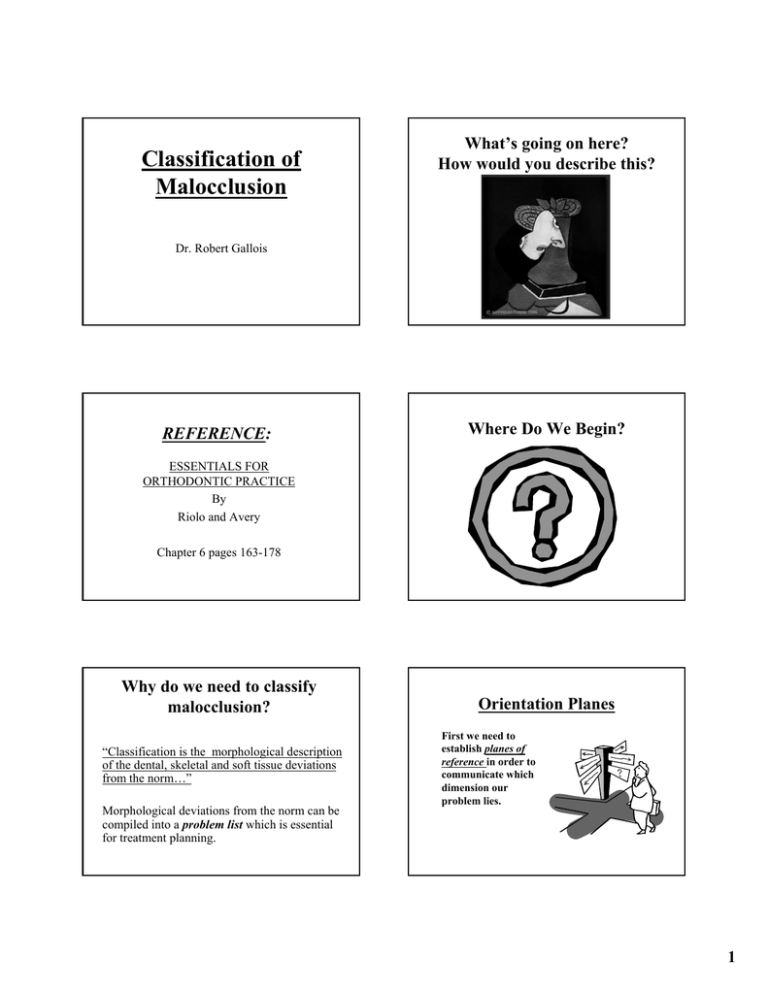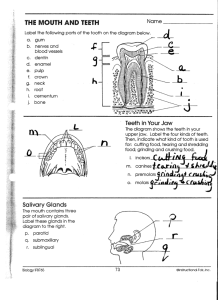Classification of Malocclusion
advertisement

Classification of Malocclusion What’s going on here? How would you describe this? Dr. Robert Gallois REFERENCE: Where Do We Begin? ESSENTIALS FOR ORTHODONTIC PRACTICE By Riolo and Avery Chapter 6 pages 163-178 Why do we need to classify malocclusion? “Classification is the morphological description of the dental, skeletal and soft tissue deviations from the norm…” Morphological deviations from the norm can be compiled into a problem list which is essential for treatment planning. Orientation Planes First we need to establish planes of reference in order to communicate which dimension our problem lies. 1 Sagittal Plane A.K.A. MEDIAN PLANE An imaginary plane that passes longitudinally through the middle of the head and divides it into right and left halves. Used to describe anterior-posterior relationships. Frontal Plane A.K.A. VERTICLE PLANE An imaginary plane that passes longitudinally through the head perpendicular to the sagittal plane dividing the head into front and back. Used to describe superior-inferior relationships. Transverse Plane A.K.A. HORIZONTAL PLANE An imaginary plane that passes through the head at right angles to the sagittal and frontal planes dividing the head into upper and lower halves. Used to describe right to left relationships. Soft Tissue Relationships BRACHYCEPHALIC describes an individual with a larger than average cranial width and usually presents with a broad, square head shape and low mandibular plane angle. BRACHYFACIAL is an individual characterized by a broad square face with a strong chin, flat lip posture, low mandibular plane angle and a straight profile. DOLICOCEPHALIC describes an individual that has a narrower cranial width and usually presents with a long, narrow shape and high mandibular plane angle. DOLICOFACIAL is an individual that has a long, narrow face with a high mandibular plane angle, convex profile, poor chin development and an anterior-posterior face height imbalance. 2 Facial Midline MESOCEPHALIC describes an individual that falls between the brachycephalic and dolicocephalic types and has an average cranial width. MESOFACIAL is an individual who has well balanced facial features. A line drawn perpendicular to the interpupillary line from glabella to the tip of the nose, passing through the philtrum of the upper lip, and the midline of the chin Dental Midline Frontal Facial View Asymmetry A reduction of proportion between the left and right sides of the face. Often associated with syndromes which can complicate treatment. Maxillary Dental Midline A line drawn perpendicular to the maxillary occlusal plane through the proximal contacts of the central incisors. Mandibular Dental Midline A line drawn perpendicular to the mandibular occlusal plane through the proximal contacts of the central incisors. Lip Line The amount of tooth and/or gingival tissue that is exposed at rest. Smile Line The amount of tooth and/or gingival tissue exposed upon smiling. 3 Lip Incompetence Straight Profile The inability of the patient to have the lips contacting in the rest position without showing muscle strain. Convex Profile Profile Facial View Profile Facial View Concave Profile The profile facial view is use to evaluate the the nose, chin, lips and facial convexity. There are three profile types: Straight Convex Concave 4 Arch Forms Elliptical Dental Relationships Square Tapering Crowding Terms to Consider Arch form= Shape of the individual dental arches. Crowding= Dental misalignment caused by inadequate space for the teeth. Diastema=A space between two or more teeth in the dental arch. Supernumerary teeth= Extra teeth that usually erupt ectopically. Anodontia= Congenitally missing teeth. Arch Form Diastema Arch Length 2 1 1 2 3 3 4 4 5 Mesial 1st Molar 6 5 Arch Width Mesial 1st Molar 6 5 Supernumerary Teeth Terms used to describe the position of teeth. Mesioversion Distoversion A tooth in the arch located more mesial than normal Labioversion Buccoversion Linguoversion Infraversion Supraversion Torsiversion Transversion (Transposition) An incisor or canine outside of arch towards the lips A tooth in the arch located more distal than normal A posterior tooth outside the arch toward the cheek A tooth inside the arch form toward the tongue A tooth that has not erupted to the occlusal plane A tooth the has over-erupted A tooth rotated on its axis Teeth that are in the wrong sequential order. Supernumerary Teeth Sagittal Dental Relationships Anodontia Angle Classification • In 1890 Edward H. Angle published the first classification of malocclusion. • The classifications are based on the relationship of the mesiobuccal cusp of the maxillary first molar and the buccal groove of the mandibular first molar!!!!!! • If this molar relationship exists then the teeth can align into normal occlusion. 6 Normal Occlusion Class II Malocclusion The mesiobuccal cusp of the maxillary first molar is aligned with the buccal groove of the mandibular first molar. There is alignment of the teeth, normal overbite and overjet and coincident maxillary and mandibular midlines. Class I Malocclusion Class II Malocclusion Class II Malocclusion has two divisions to describe the position of the anterior teeth. Class II Division 1 is when the maxillary anterior teeth are proclined and a large overjet is present. Class II Division 2 is where the maxillary A normal molar relationship exists but there is crowding, misalignment of the teeth, cross bites, etc. Class II Malocclusion anterior teeth are retroclined and a deep overbite exists. Class II Malocclusion Division 1 Division 2 A malocclusion where the molar relationship shows the buccal groove of the mandibular first molar distally positioned when in occlusion with the mesiobuccal cusp of the maxillary first molar. 7 Class III Malocclusion Transverse Dental Relationships A malocclusion where the molar relationship shows the buccal groove of the mandibular first molar mesially positioned to the mesiobuccal cusp of the maxillary first molar when the teeth are in occlusion. Class III Malocclusion Posterior Crossbites A Posterior Crossbite is present when posterior Anterior Tooth Positions teeth occlude in an abnormal buccolingual relation with the antagonistic teeth. Posterior Crossbites can be the result of either malposition of a tooth or teeth, and/or the skeleton. Examining the transverse dimension allows us to evaluate the intermolar and intercanine widths and determine which arch is the offending unit. Posterior crossbites can be unilateral or bilateral. A Functional Crossbite results from an occlusal interference that requires the mandible to shift either anteriorly and/or laterally in order to achieve maximum occlusion. Posterior Crossbite Overjet is a term used to describe the distance between the labial surfaces of the mandibular incisors and the incisal edge of the maxillary incisors. Anterior Crossbite is a malrelation between the maxillary and mandibular teeth when they occlude with the antagonistic tooth in the opposite relation to normal. 8 Overbite Posterior Crossbite The amount of overlap of the mandibular anterior teeth by the maxillary anterior teeth measured perpendicular to the occlusal plane. Normal Overbite Descriptive Crossbite Terms Buccal Crossbite Buccal displacement of the affected posterior tooth or teeth as it relates to the antagonistic posterior tooth or teeth. Lingual Crossbite Lingual displacement of the mandibular affected tooth or teeth as it relates to the antagonistic tooth or teeth. Palatal Crossbite Palatal displacement of the maxillary affected tooth or teeth as it relates to the antagonistic tooth or teeth. Complete Crossbite When all the teeth in one arch are positioned either inside or outside to all the teeth of the opposing arch. Scissor-bite Present when one or more of the adjacent posterior teeth are either positioned completely buccally or lingually to the antagonistic teeth and exhibit a vertical overlap. Deep Overbite Open Bite An open bite is present when there is no vertical overlap of the maxillary and mandibular anterior teeth or no contact between the maxillary and mandibular posterior teeth. Ankylosis Vertical Dental Relationships The fusion between the teeth and the alveolar bone. Ankylosed teeth do not erupt with the vertical growth of the patient and are seen in the infraversion position. 9 Skeletal Patterns Skeletal Pattern II I III Cephalometric Analysis Used to evaluate the relationships between the teeth, soft tissue and the skeleton. The Lateral Cephalometric Radiograph gives the orthodontist a sagittal view of the skeletal, dental and soft tissues. An analysis can then be performed by tracing or digitizing the radiograph and making the appropriate measurements. Skeletal Patterns Cephalometric analyses reveal to the orthodontist the skeletal component of the patient’s malocclusion. We can classify patients as a : Class I Skeletal Pattern Class II Skeletal Pattern Class III Skeletal Pattern These patterns often correspond with the Angle Classification but not necessarily all the time. Understanding the skeletal pattern is essential for choosing the proper treatment mechanics. Hyperdivergent Skeletal Pattern A skeletal pattern that deviates from the norm in that there is an excessive divergence of the skeletal planes (determined by the analysis used.) Characterized by a steep mandibular plane angle, a long anterior lower face height with open bite tendency, lip incompetence and often associated with Class II malocclusion. Hypodivergent Skeletal Pattern A skeletal pattern in which the skeletal planes are more parallel to each other. Characterized by a low mandibular plane angle, short lower facial height and is often associated with Class II Division 2 malocclusions. 10 Prognathism Prognathism is a skeletal protrusion. Bimaxillary Prognathism (Protrusion) is present when both jaws protrude forward of the normal facial limits. Maxillary Prognathism (Protrusion) is present when the maxilla protrudes forward of the normal limits of the face. Mandibular Prognathism (Protrusion) is when the mandible protrudes forward of the normal limits of the face. Prognathism Normal Bimaxillary Prognathism Mandibular Prognathism (Protrusion) Retrognathism Retrognathism is a skeletal retrusion. Bimaxillary Retrognathism (Retrusion) is present when both jaws are posterior to the normal limits of the face. Maxillary Retrognathism (Retrusion) is present when the maxilla is posterior to the normal limits of the face. Mandibular Retrognathism (Retrusion) is present when the mandible is posterior to the normal limits of the face. Retrognathism Normal Bimaxillary Retrognathism Mandibular Retrognathism (Retrusion) 11 Dentoalveolar Protrusion Dentoalveolar Protrusion is present when the anterior teeth are positioned forward of the normal limits of the basal bone. Bimaxillary Dentoalveolar Protrusion is present when the anterior teeth of both jaws are forward of the normal limits of the basal bone. Maxillary Dentoalveolar Protrusion is present when the maxillary anterior teeth are forward of the normal limits of the basal bone. Mandibular Dentoalveolar Protrusion is present when the mandibular anterior teeth are forward of the normal limits of the basal bone. Dentoalveolar Protrusion Normal Bimaxillary Dentoalveolar Protrusion Bimaxillary Dentoalveolar Protrusion Dentoalveolar Retrusion Dentoalveolar Retrusion is present when the anterior teeth are posterior to the normal limits of the basal bone. Bimaxillary Dentoalveolar Retrusion is present when the anterior teeth of both jaws are posterior to the normal limits of the basal bone. Maxillary Dentoalveolar Retrusion is present when the anterior teeth of the maxilla are posterior to the normal limits of the basal bone. Mandibular Dentoalveolar Retrusion is present when the anterior teeth of the mandible are posterior to the normal limits of the basal bone. Dentoalveolar Retrusion Normal Bimaxillary Dentoalveolar Retrusion So what does this all mean? 12






